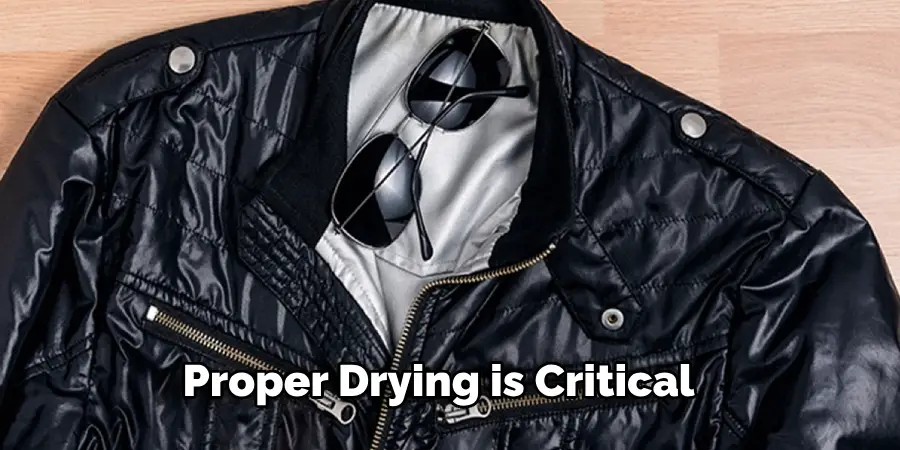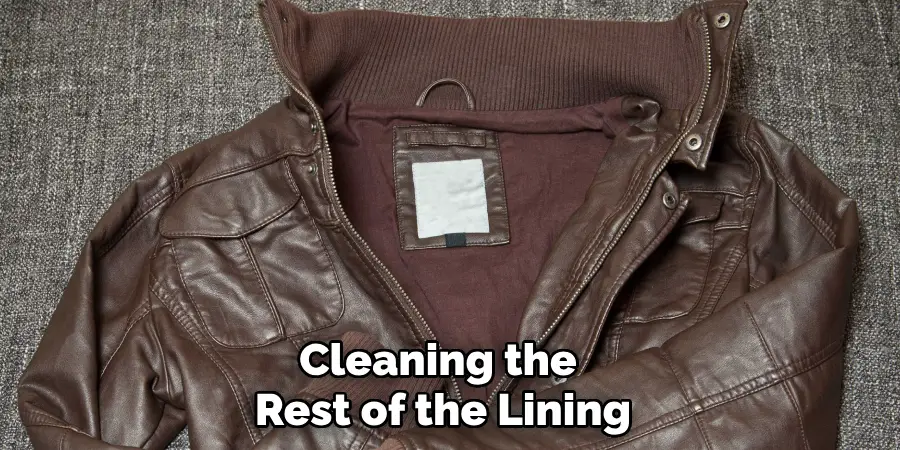Keeping the lining of a leather jacket clean is crucial for maintaining both comfort and hygiene, as it frequently comes into direct contact with the body. Over time, the lining can absorb sweat, oils, and lingering odors, potentially diminishing the jacket’s overall appeal and wearability.

Unlike the leather exterior, which requires specific care to preserve its texture and durability, cleaning the lining involves a more delicate approach. Understanding how to clean lining of leather jacket is essential to ensure it remains fresh and comfortable without causing harm.
Emphasizing a gentle hand-cleaning process, it’s important to carefully spot clean, use appropriate deodorizing techniques, and follow correct drying methods to protect the lining. This attention to detail prolongs the jacket’s life and ensures a pleasant wearing experience. In the following sections, we’ll explore effective strategies for maintaining a clean jacket lining.
Materials Needed
Having the right materials ensures an effective and safe process when preparing to clean the lining of a leather jacket.
Mild Detergent or Gentle Fabric Cleaner: Opt for a mild, non-toxic cleaner that is safe for delicate fabrics, such as wool or silk, which are often used as jacket linings. This ensures the cleaning solution is gentle enough to not damage these sensitive materials and effectively remove oils and stains.
Warm Water: Warm water is essential for diluting the detergent and aiding in cleaning. It helps to loosen dirt and residues without being harsh on the lining fabric.
Soft Sponge or Cloth: A soft sponge or cloth is used to gently clean the fabric lining. Harsh scrubbing should be avoided to prevent damage. The softness of the material helps the cleaner to be applied without causing abrasion.
Baking Soda (Optional): If odors are a concern, baking soda can be used to naturally absorb and neutralize them, leaving the lining fresher.
Spray Bottle (Optional): A spray bottle can help apply the water-detergent mixture evenly across the lining, allowing for a more controlled application and preventing oversaturation of the fabric.
Hangers or Clothesline: Finally, proper drying is critical. Use hangers or a clothesline to allow the jacket to air-dry thoroughly, ensuring it maintains its shape and structure. Proper drying is key to preserving the longevity and appearance of your leather jacket.

Preparing the Jacket for Cleaning
Turn the Jacket Inside Out
First, lay the jacket flat on a clean surface with the back facing up. Start with one sleeve and gently pull it through the jacket to expose the lining. Repeat with the other sleeve until the entire lining is facing outward.
Turning the jacket inside out ensures you clean only the lining, avoiding contact with the leather exterior. This position also allows you to inspect the lining for stains, discolorations, or areas that have experienced heavy wear, helping to focus your cleaning efforts where needed.
Dusting Off Surface Debris
Once the jacket is inside out, use a soft cloth or a brush with gentle bristles to dust off any loose dirt, lint, or debris from the lining. Avoid pressing too hard to prevent damage to the delicate fabric. Removing surface debris ensures the cleaning solution can penetrate more effectively, reducing the chances of rubbing dirt into the fabric.
Testing for Colorfastness
Before applying the cleaning solution, it’s crucial to test for colorfastness to avoid causing damage. Choose a small, inconspicuous lining area, like a seam or corner, to apply a small amount of the detergent or cleaner. Dab gently with a soft cloth, allowing the solution to sit for a few minutes.
Check for any signs of discoloration, fading, or fabric damage. If the area remains unchanged, proceed with cleaning the rest of the lining, confident that the solution is safe to use. If any adverse reactions occur, switch to a gentler detergent.

How to Clean Lining of Leather Jacket: Spot Cleaning the Lining
Mixing the Cleaning Solution
To start the spot-cleaning process, you must prepare a gentle cleaning solution. Carefully dilute a mild detergent or gentle fabric cleaner in a bowl of warm water. Aim to mix 1-2 tablespoons of the detergent in about a quart of water.
This ratio ensures that the cleaning solution is strong enough to tackle stains and odors without being too harsh for the sensitive lining fabrics often used in leather jackets.
Spot Cleaning with a Sponge or Cloth
Once your cleaning solution is ready, it’s time to focus on the stained or soiled areas of the lining. Take a soft cloth or sponge and dip it into the cleaning mixture. Be sure to wring it out thoroughly to avoid over-wetting the fabric, which can lead to watermarks or other types of damage.
Gently dab and rub the cloth over the targeted areas of the lining. Pay particular attention to the armpits, collar, and hem—typical spots where sweat and oils accumulate. Use a combination of light dabbing and soft, circular motions to lift away dirt without aggressive scrubbing, which might harm the fabric.
Avoiding Excess Moisture
It’s crucial to exercise caution during this stage to prevent oversaturation. The goal is to clean effectively while keeping the fabric relatively dry. Excess moisture can potentially harm delicate linings, causing fabric issues or leaving watermarks. Therefore, always blot gently and use circular motions to dislodge dirt gently without exerting too much force.
Rinsing with Clean Water
After addressing the soiled areas, rinse the cloth or sponge in clean water and wring it out again to ensure it’s just damp. Use this to wipe away any detergent residue, as any leftover soap can attract dirt and result in unpleasant odors over time. Removing all traces of the detergent ensures that the lining stays clean and fresh for longer, reducing the likelihood of future cleaning being necessary soon.

How to Clean Lining of Leather Jacket: Deodorizing the Lining
Using Baking Soda for Odor Removal
Baking soda is a natural and effective way to eliminate odors from jacket linings. It absorbs unwanted smells rather than masking them, leaving the fabric fresh and odor-free. This method is particularly useful for linings that have developed musty or stale odors over time.
Step-by-Step Instructions for the Baking Soda Method
- Sprinkle Baking Soda: Lightly sprinkle a thin layer of baking soda across the entire lining with the jacket turned inside out. Focus on areas that tend to absorb more odor, like the armpits and collar.
- Let It Sit: Allow the jacket to sit undisturbed for several hours, preferably overnight. This gives the baking soda ample time to absorb any odors effectively.
- Remove Residue: After the waiting period, gently shake the jacket to loosen the baking soda. Use a soft brush or cloth to carefully brush away any remaining baking soda particles. Ensure all residues are removed to prevent any residue from interacting with moisture later on.
Air Freshening with White Vinegar (Optional)
For additional deodorizing, consider using white vinegar, which helps neutralize odors safely. Here’s how to use it:

- Prepare the Solution: Mix equal parts of white vinegar and water in a spray bottle. To avoid damage, always test the solution on a small, inconspicuous lining section first.
- Light Spritz: If no adverse effects appear, lightly spritz the lining with the solution. Avoid soaking the fabric; aim for a gentle misting.
- Air Out: Finally, let the jacket air out completely. Hang it in a well-ventilated area to ensure it dries thoroughly, allowing any remaining vinegar smell to dissipate. This method effectively removes odors without leaving a vinegar scent behind.
Drying the Jacket Properly
Air Drying the Lining
After cleaning, turn the jacket inside out and place it on a sturdy hanger. This position allows ample airflow through the fabric, promoting even drying. Ensure the hanger is strong enough to support the jacket’s weight and prevent shape distortion.
Air drying is the safest method as it avoids the risks associated with shrinkage or damage, which can occur with alternative drying methods. Hang the jacket in a well-ventilated space where it can dry naturally without interference from harsh elements.
Avoiding Heat Sources
When drying the jacket, it’s crucial to avoid using heat sources such as dryers, radiators, or direct sunlight. These heat sources can cause irreversible damage to both the lining and the leather exterior, potentially leading to cracking, shrinking, or fading. The gentle approach to air drying minimizes the risk of heat-related damage, preserving the jacket’s integrity and appearance.
Allowing for Sufficient Drying Time
Leave the jacket to air dry for a minimum of 24-48 hours. This duration ensures that even the interior layers dry thoroughly, preventing any latent moisture that might lead to mildew or unpleasant odors.
Only once the lining feels completely dry should the jacket be considered ready for wearing or storing. Patience with this process of drying the jacket, it’s crucial to avoid using heat sources such as dryers, radiators, or direct sunlight, is essential for maintaining the jacket’s quality and longevity.
Long-Term Care for the Lining
Regular Freshening Up
Proper long-term care of a leather jacket’s lining involves consistent freshening up to maintain its condition and aroma. After wearing the jacket, turning it inside out and allowing it to air out in a well-ventilated area is advisable. This practice helps to prevent odors from settling into the fabric by allowing moisture and body oils to disperse naturally.
Using Deodorizing Packs
Use deodorizing packs such as activated charcoal or silica gel to combat moisture buildup and lingering odors. These packs can be placed in the closet where the jacket is stored or hung inside the jacket itself. They effectively absorb excess moisture and neutralize odors, enhancing the freshness of the lining over time.
Washing Frequency
For the longevity of the jacket lining, it’s crucial to adopt a balanced cleaning routine. Rather than frequent deep cleanings, which can wear delicate fabrics, focus on spot-cleaning areas prone to heavy sweating or dirt accumulation as needed. This targeted approach helps maintain cleanliness without compromising fabric integrity.
Using Underarm Shields or Wearable Layers
Wear underarm shields or additional clothing layers beneath the jacket to protect the lining from direct contact with sweat and body oils. These preventive measures significantly reduce the need for frequent cleanings, preserving the quality and longevity of the jacket lining while ensuring it remains fresh and odor-free.

Conclusion
Regularly cleaning and deodorizing the lining of a leather jacket is vital for maintaining its comfort and freshness. Consistent care ensures that your leather jacket remains stylish, hygienic, and pleasant to wear. By following simple steps for spot cleaning, deodorizing, and air drying, you can significantly extend the lifespan of the lining and the jacket.
These practices prevent unwanted odors and preserve the integrity of delicate fabrics, keeping the jacket looking and feeling its best over time. Understanding how to clean lining of leather jacket equips you with the knowledge to protect your investment and ensure that it continues to provide warmth and elegance year after year.
Take the time to incorporate these care techniques into your routine, and you’ll be rewarded with a jacket that remains as appealing and functional as the day you first wore it.

